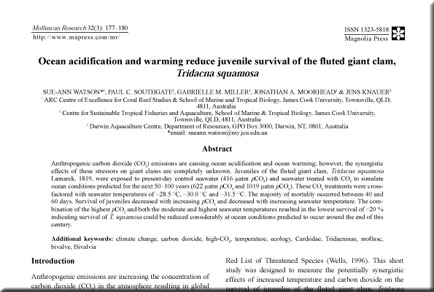Abstract
Anthropogenic carbon dioxide (CO2) emissions are causing ocean acidification and ocean warming; however, the synergistic effects of these stressors on giant clams are completely unknown. Juveniles of the fluted giant clam, Tridacna squamosa Lamarck, 1819, were exposed to present-day control seawater (416 μatm pCO2) and seawater treated with CO2 to simulate ocean conditions predicted for the next 50–100 years (622 μatm pCO2 and 1019 μatm pCO2). These CO2 treatments were cross-factored with seawater temperatures of ~28.5 °C, ~30.0 °C and ~31.5 °C. The majority of mortality occurred between 40 and 60 days. Survival of juveniles decreased with increasing pCO2 and decreased with increasing seawater temperature. The com-bination of the highest pCO2 and both the moderate and highest seawater temperatures resulted in the lowest survival of <20 % indicating survival of T. squamosa could be reduced considerably at ocean conditions predicted to occur around the end of this century.

